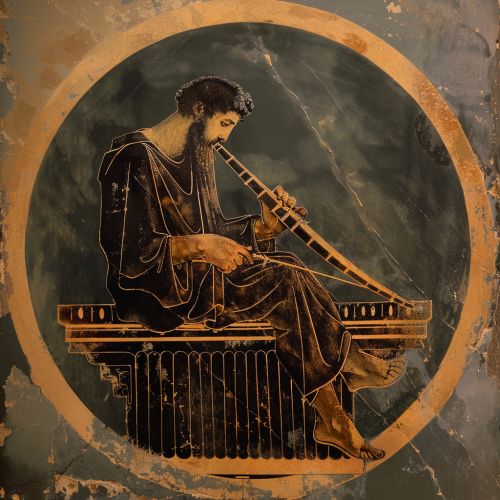Barbiton
Overview
The barbiton, also known as the barbitos, is an ancient stringed musical instrument that was popular in ancient Greece and Rome. It is a member of the lyre family, characterized by its deep, resonant sound and long strings. The barbiton was primarily used in a variety of musical contexts, including religious ceremonies, theatrical performances, and private entertainment. Its construction, playing techniques, and historical significance offer a fascinating glimpse into the musical culture of antiquity.


Historical Background
The barbiton has its origins in ancient Greece, with references to the instrument appearing in texts dating back to the 6th century BCE. It was particularly associated with the lyric poets of the time, such as Anacreon and Sappho, who often accompanied their verses with music played on the barbiton. The instrument was later adopted by the Romans, who referred to it as the "barbitos."
The barbiton was considered a sophisticated instrument, often linked with the Muses, the goddesses of the arts and sciences. It was also associated with the Dionysian Mysteries, religious rites dedicated to the god Dionysus, where music played a crucial role in the ceremonies.
Construction and Design
The barbiton is typically constructed from wood, with a soundbox made from a single piece of hollowed-out wood or a tortoiseshell. The instrument features a long, narrow neck and a varying number of strings, usually between seven and ten. The strings were originally made from gut, although modern reconstructions may use synthetic materials.
The tuning of the barbiton strings was achieved using pegs inserted into the neck of the instrument. The strings were plucked with a plectrum or with the fingers, producing a rich, deep sound that was well-suited to accompanying vocal performances.
Playing Techniques
Playing the barbiton required a high degree of skill and dexterity. Musicians would hold the instrument against their bodies, using one hand to pluck the strings while the other hand manipulated the tuning pegs or dampened the strings to produce different pitches. The use of vibrato, glissando, and other expressive techniques added to the instrument's versatility.
The barbiton was often played in ensemble settings, alongside other instruments such as the aulos (a double-reed wind instrument) and the kithara (a type of lyre). It was also used as a solo instrument, particularly in the context of lyric poetry recitations.
Cultural Significance
The barbiton held a prominent place in ancient Greek and Roman culture. It was frequently depicted in art, including vase paintings, mosaics, and sculptures, often in the hands of muses or other mythological figures. The instrument's deep, resonant sound was considered ideal for evoking the emotional depth of lyric poetry and other forms of artistic expression.
In addition to its role in entertainment and religious ceremonies, the barbiton was also used in educational settings. Music was an integral part of the paideia, the system of education in ancient Greece, and learning to play the barbiton was considered an essential skill for young aristocrats.
Modern Revival
Interest in the barbiton has seen a resurgence in recent years, driven by a growing fascination with ancient music and historical performance practices. Modern reconstructions of the instrument have been created based on archaeological findings and historical descriptions, allowing contemporary musicians to explore the unique sound and playing techniques of the barbiton.
Ensembles specializing in ancient music, such as Ensemble Kérylos and Musica Romana, have incorporated the barbiton into their performances, bringing the instrument's rich heritage to new audiences. These efforts have contributed to a deeper understanding of the musical traditions of antiquity and the enduring legacy of the barbiton.
